Guided Walking Tours
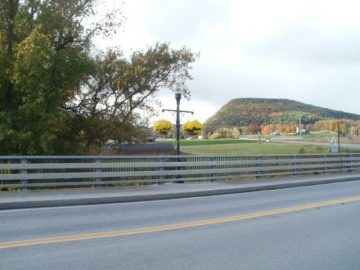
A view of Vroman’s Nose from the bridge over Schoharie Creek in Middleburgh is just one of many breathtaking sights to see while taking in centuries of history.
Few places can match Schoharie County for its combination of picturesque beauty and historical legacy. With rolling hills, dramatic valleys and countless natural wonders as a vibrant backdrop, just about every step in the county leads to ground that has compelling stories rooted in its soil that beg to be told and retold. Historical markers and a handful of buildings that escaped the Revolution unscathed remind the casual passerby that history happened here, but also leaves more curious people asking how can I get the rest of the story? We can help with that.
For anyone who has taken historical tours in cities with many surviving colonial-era buildings or on prominent battlefields with roads, trails and signs to help describe events, taking these tours is a little different. There are few buildings to help narrate the stories and historical markers barely scratch the surface of the history that inspired them. That is because the American Revolution happened here, with brutal ferocity, and not much survived of “Old Schohary”. The land, then, becomes the monument and the soil hallowed ground. Battles were fought here. Beginning with native occupation thousands of years before the first Europeans trod in what is now Schoharie County, people lived and died here ever toiling to provide a future for their children. Some succeeded. Some failed. Many, however, were destined to participate in events of legend. These tours are about marrying the dramatic moments in their lives to the landscape they toiled upon for a better life and were prepared to die to protect.
Tour Schedule & Guide Fees
Currently, we offer five highly informative guided walking tours that pass through three villages – Schoharie, Middleburgh, Cobleskill – and the Cobleskill Battlefield. Colonial era sites are most heavily concentrated in the Villages of Schoharie and Middleburgh. New for 2020 is that the Village of Schoharie is now broken up into two distinct walking tours: Foxestown at the northern end and Fountaintwon at the southern end. Both offer many colonial and Revolutionary War sites, plus a whole lot more. The Village of Cobleskill has several Colonial era sites, but is chiefly a Gilded Age tour. The Cobleskill Battlefield is where an important Revolutionary War battle was fought on May 30, 1778. Our current schedule is found HERE. Please see all five tour descriptions below.
The guide service for each scheduled tour is $10.00 per person age 18 and over. For ages 9-17 it is $5.00 per child. Ages 8 and under are free. Group discounts are available for parties of 10 or more if pre-arranged. Go HERE for all inquiries. At this time, payment must be made by cash or check. Dress appropriately for the weather and wear comfortable shoes. Our policy is that if just one person is game to take a tour in inclement weather like rain, snow, or high wind, we proceed. Don’t forget to bring a camera!
Private Walking Tours
Private walking tours can be arranged. They may or may not have to be the same routes or locations as the four that are regularly scheduled. Whether you’re looking to book a special outing for an historical organization, a team-building experience for your employees, walk in the footsteps of ancestors as part of a family reunion, or just because you and your friends or family are history nerds like Jeff and Pam, we will make every effort to make your tour informative, enjoyable and memorable. Go HERE to contact us.
Village of Schoharie – Fountain Town (South)
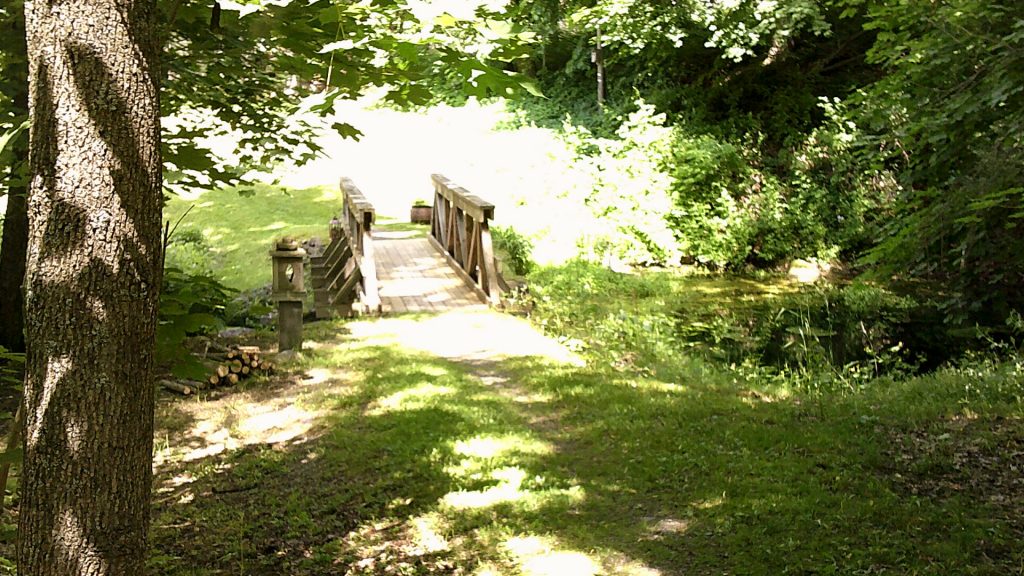
A wooden footbridge over a quiet, secluded spring provides a perfect way to step back into the 18th century. The path leads to the 1743 Lutheran Parsonage, home of Rev. Peter N. Sommer for almost half a century.
Fountain Town was the first dorf, or German farming village settled by the first European settlers who arrived in the Schoharie Valley in the fall of 1712. These settlers were refugees from German principalities along the Rhine River and its tributaries who fled war, disease, and famine. Eventually, they ended up in New York and some came to the Schoharie Valley. Since most came from the Palatinate, they were known collectively as Palatines even though many came from neighboring principalities and even Switzerland. Fountain Town is the English version of Brunnen Dorf, both of which refer to the springs that issued from the limestone hillside.
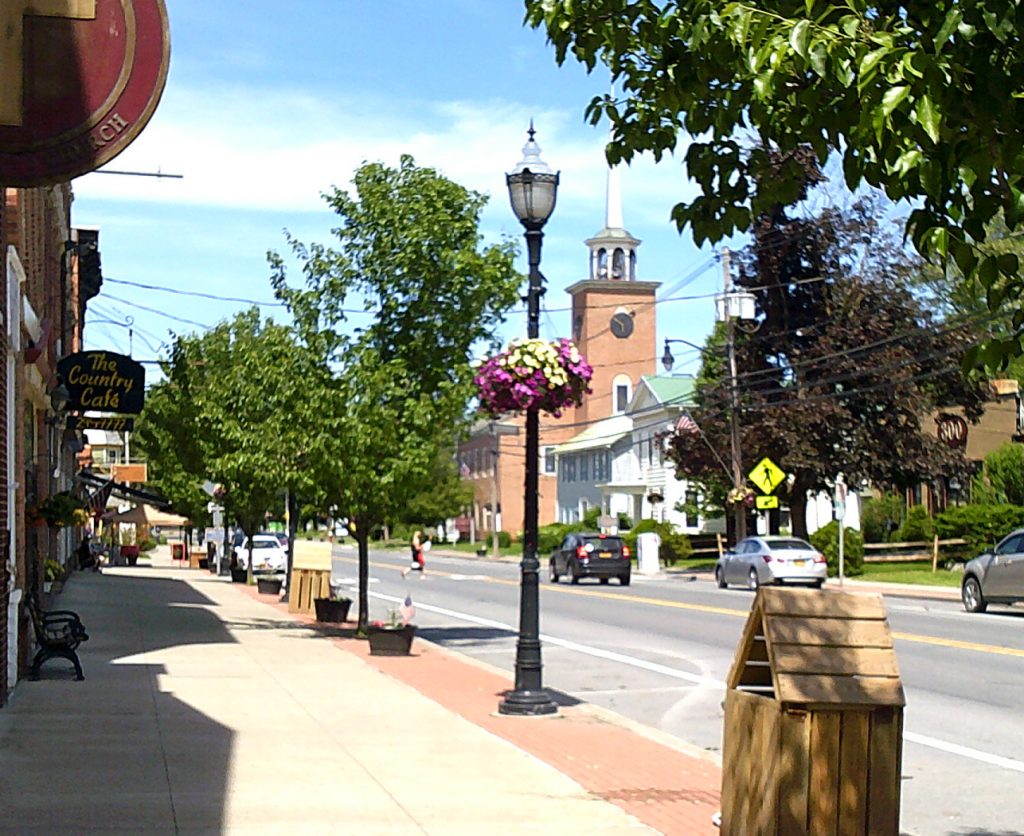
Quaint Main Street, with St. Paul’s Presbyterian Church, originally built as a Lutheran church in 1796, in the distance.
Featured on this tour are colonial and Revolutionary War sites. Also prominent is late 18th century architecture that helps tell the story of the post-war economy and rebirth of the village. Part of the narrative includes the development of the Village of Schoharie from a small German farming village to a thriving business district by the late 19th century. The tour will also present much Civil War history, both local anecdotes and the places and events soldiers from Schoharie County participated in. There is a nice variety of historical interest here, with some surprises along the way.
The tour is approx. 1.5 miles and about 1.5 to 2 hrs long. Some grassy surfaces, but mostly sidewalks on route. It begins at the largest municipal parking lot on Spring St (off Main/Rte 30) in the Village of Schoharie – across the street from the village pool.
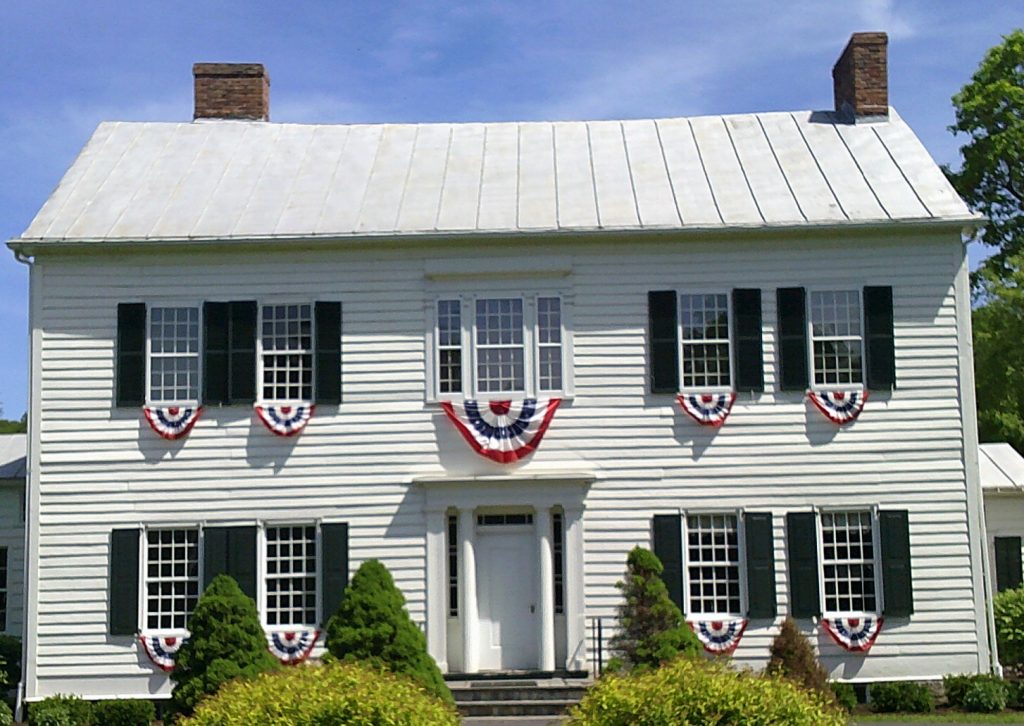
Lasell Hall, built by John J. Lawyer as a tavern in 1795 and currently the home of the Schoharie Chapter of the Daughters of the American Revolution.
Some highlights of the Fountain Town Tour are the 1743 Lutheran Parsonage, 1796 St. Paul’s Lutheran Church, 1795 Lasell Hall, 1790 Johannes Lawyer, Jr. home, Throop Drug Store, Parrott House, First Street Movies, Wood’s Hotel, Camp Vedder (Civil War), Railroad, 19th century businesses, the Great Fires, the murders of 1818, the 1750 Lutheran Church, Reverend Peter N. Sommer and family & much more!
Village of Schoharie – Foxes Town (North)
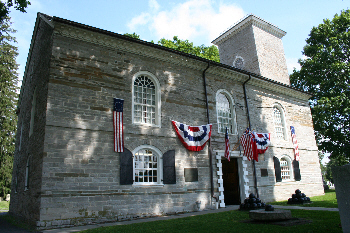
Old Stone Fort Museum, once a High Dutch Reformed Church built in 1772 and fortified as the Lower Fort in the fall of 1777.
Foxes Town was settled around the spring of 1713 by Palatines led by William Fuchs, who originally named it Fuch’s Dorf; the English later called it Foxes Town. Nearby Fox Creek empties into the Schoharie Creek just a little north. Nearby are several native occupation sites that help tell the story of European contact & the how the 18th century Mohawk/Hodenosaunee culture engaged with the German and Dutch cultures of the Schoharie Valley.
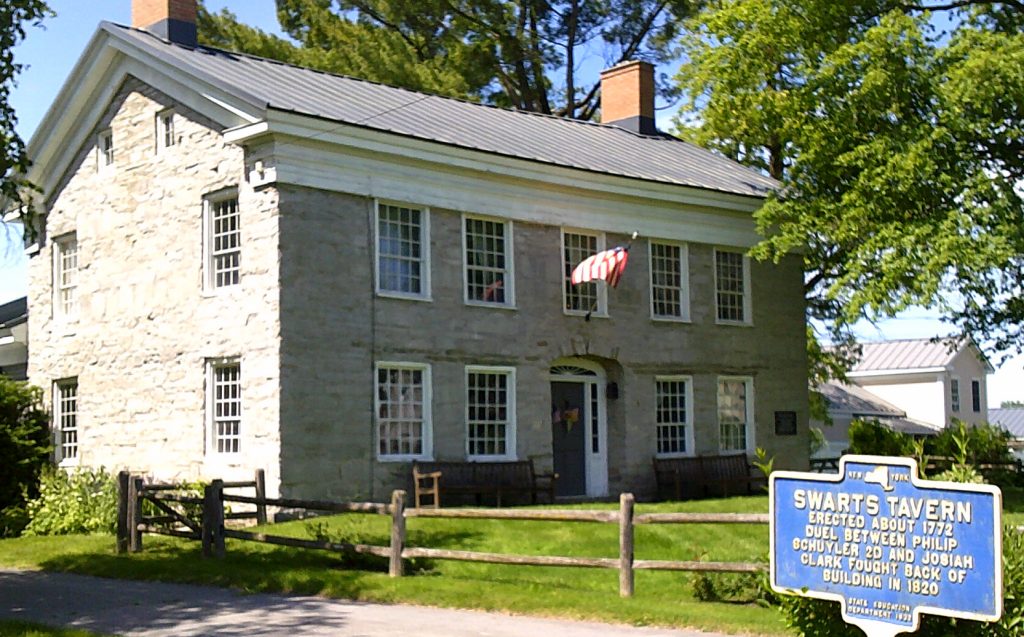
An elegant home built by Johannes Lawyer in 1772, later known as Swarts Tavern, provides a fine visual example of how Foxes Town fared economically just prior to the dawn of the American Revolution.
This tour features the best glimpse of the pre-Revolutionary War period of the Schoharie Valley – or the western New York frontier – that exists today. Other places along the Mohawk Valley have colonial-era buildings still standing here and there, but none past Schenectady has as significant a cluster as the northern end of the Village of Schoharie. The story of colonial development and economic wealth just prior to the American Revolution is told here, along with the devastating impact of the Revolution. The Sir John Johnson Raid of 1780 figures prominently, as does the fort now known as the Old Stone Fort. More post-war 18th and early 19th century archicture awaits, along with descriptions of old Foxes Town.
The tour is approx. 1.5 miles and about 1.5 to 2hrs long. Some grassy surfaces, but mostly road surfaces. It begins at the parking lot used by the Easter Egg Museum and visitors of the covered bridge, off Rte 443 just after its junction with Rte 30.
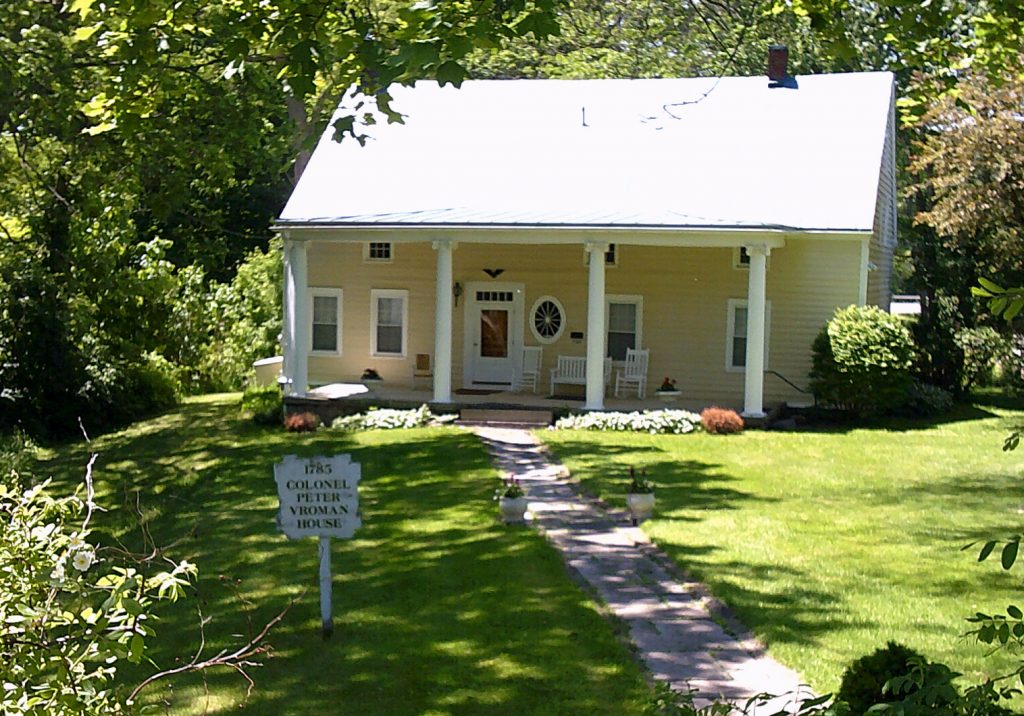
The quiet former home of Colonel Peter Vrooman, who lived here after leading the local militia defense of Schoharie District during the Revolution. In combination with a nearby covered bridge spanning over Fox Creek, the site offers an exquisite slice of country living at its finest.
Highlights along this tour include the Old Stone Fort, Lower Fort stockade, High Dutch Churches, High Dutch Church parsonage, the old King’s Highway, the Peter Mann Tavern, native occupation sites, Terrace Mountain, 1772 Lawyer home/Swart Tavern, David Williams Monument, Co. B 108th Regiment, NYSNG (Civil War era), 1780 Johnson Raid, Capt. George Mann, Thomas Eckerson property & mill, Col. Peter Vrooman post-war home, Margaret and Elizabeth Kniskern, Col. Simon Hoosac Mix, the Old Stone Fort museum buildings & much more!
Village of Middleburgh
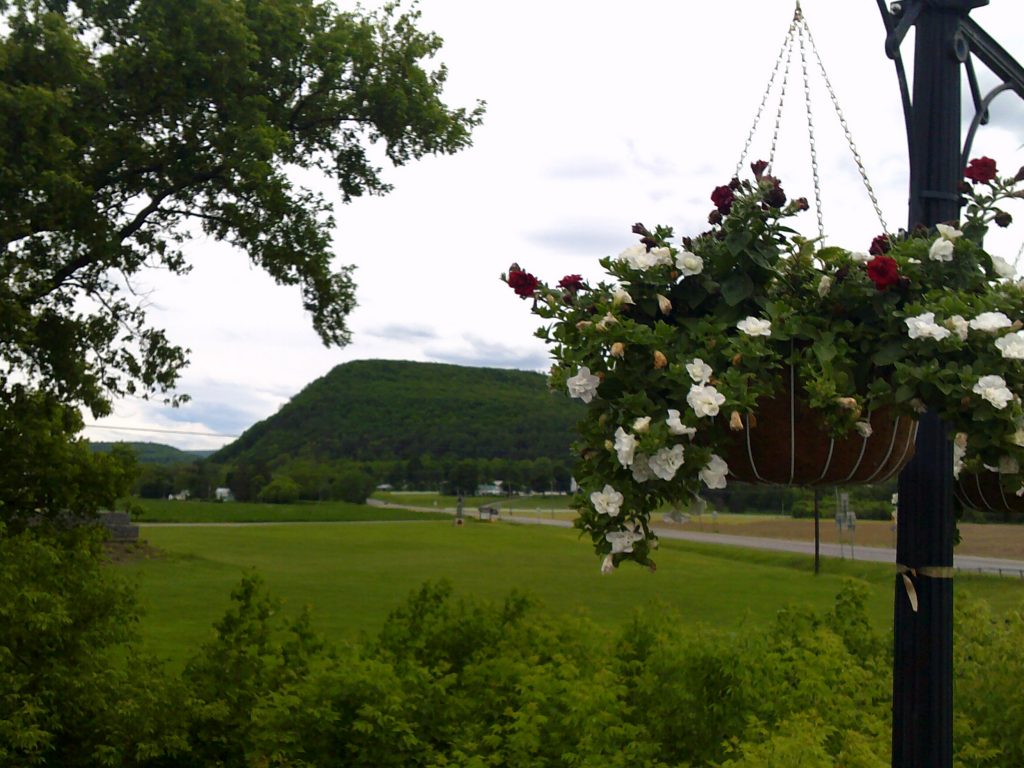
The iconic profile of Vromans Nose, jutting out into the flats once known as Vromans Land and home of native occupation for thousands of years. Just part of the gorgeous landscape that surrounds the pretty Village of Middleburgh
The present Village of Middleburgh was once the Palatine settlement of Weiser’s Dorf in the early part of the 18th century. It became later known by the English as Weysers Town by the time of the American Revolution. Within view of the village is Vroman’s Nose and its adjacent flats. Here, Mohawks and other Hodenosaunee-linked cultures lived as neighbors to the Palatines and a Dutch family headed by Adam Vrooman. The surrounding area was devastated during the American Revolution as former friends and neighbors fought each other.
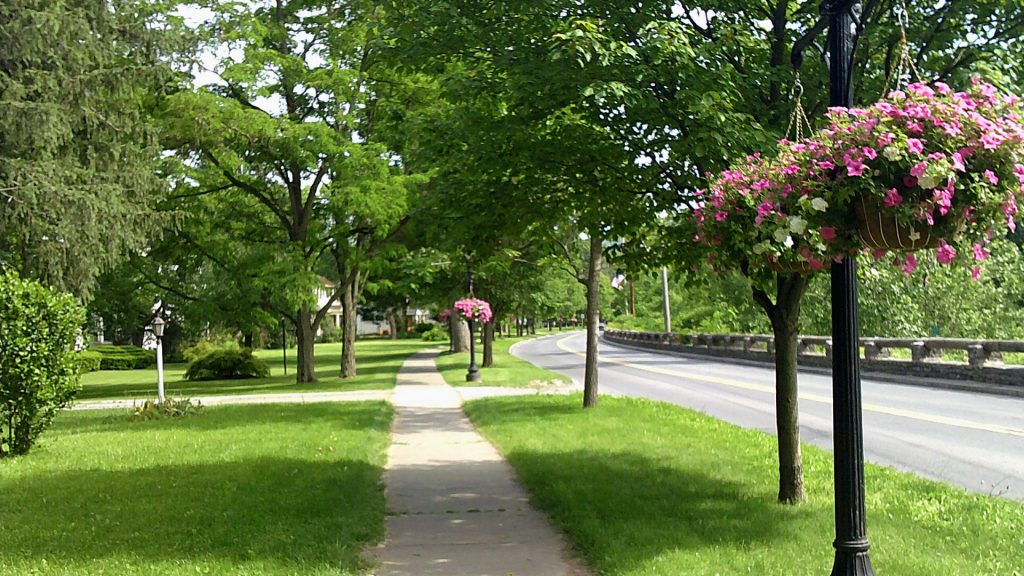
A pretty setting for a walking tour in the Village of Middleburgh along Rte 30, with the Schoharie Creek on the right, heading south toward Main Street
The village is a perfect blend of history and pretty settings for a pleasant morning stroll. From geological and natural history to the development of the village in the 19th century, there is plenty of variety in the narratives. Featured is the local diplomacy of Hodenosaunee, Dutch and German cultures in the colonial era and how these relationships were shattered during the American Revolution. The 1777 events that led to the Battle of the Flockey and the 1780 Johnson raid are prominently featured.
This tour is approx. 1.5 miles and about 1.5 to 2 hrs long. There are minimal grassy surfaces, with most walking done on sidewalks. It begins at the Middleburgh High School just off Main Stree/Rte 145 in the Village of Middleburgh. There is parking on the side and back of the school accessed by a road between the school and a Stewart’s Shoppe.
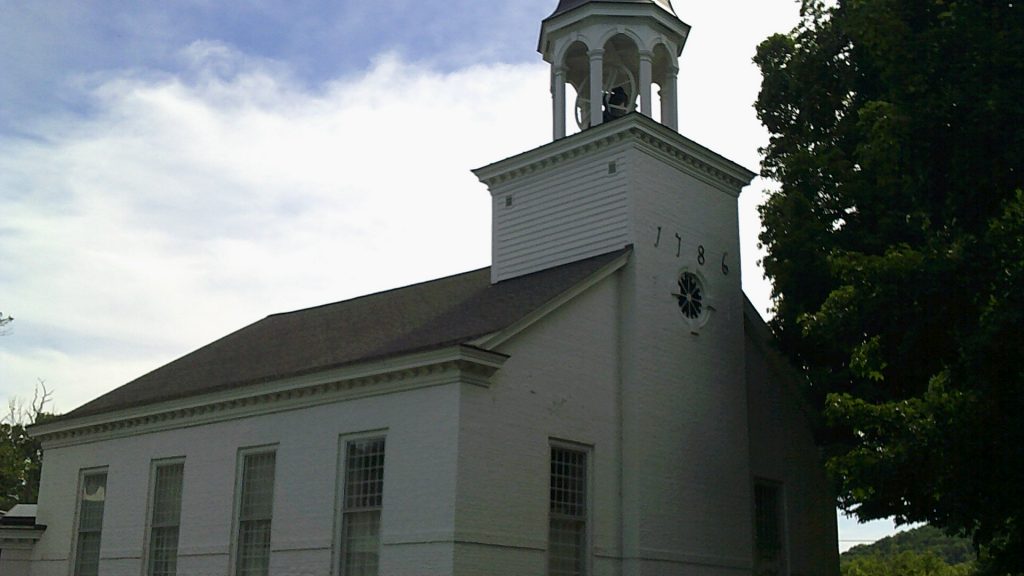
The rebuilding of the village after the American Revolution centered on this Low Dutch Reformed Church, built in 1786.
Highlights on this tour include Geology, Wisconsin Glacier, Lake Schoharie, the soil, early native and Mohawk occupation, arrival of the Palatines, the Weiser family, the Palatine experience, agricultural history, 1756 fort, Middle Fort, 1780 Johnson Raid, Timothy Murphy, 1786 Low Dutch Reformed Church, rebuilding, 19th century architecture
Cobleskill Battlefield
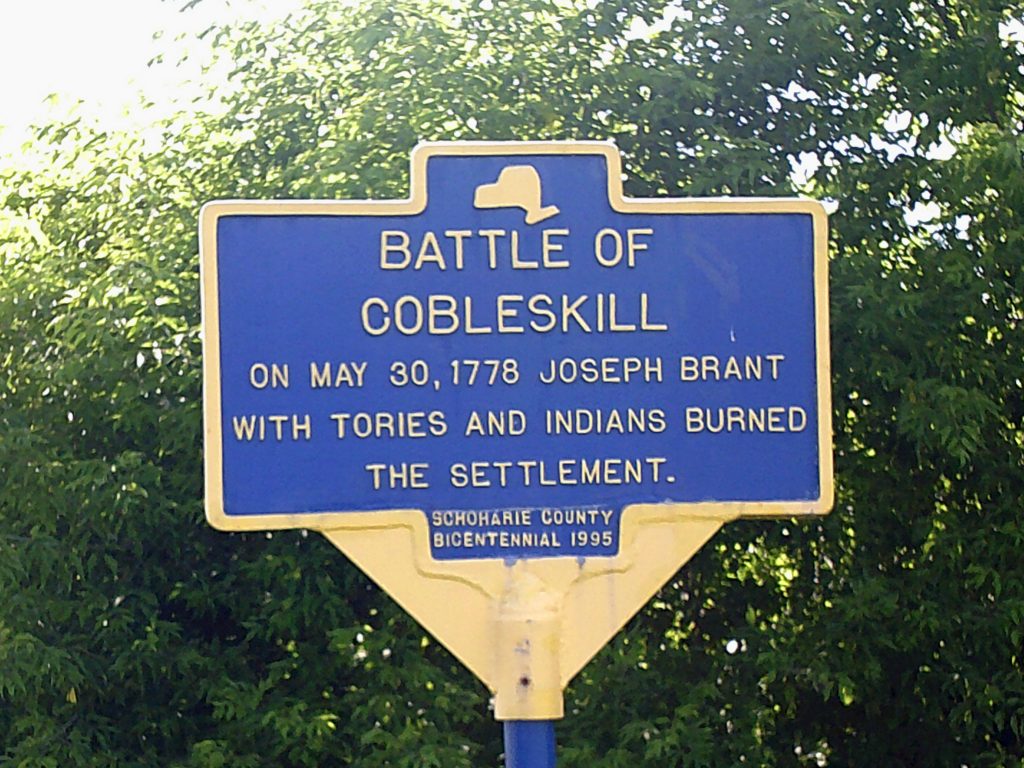
New York State marker roughly locating the tipping point of the battle approx. 1 mile away from the Warner farm near the Warnerville Cut-off road in Warnerville.
The Battle of Cobus Kill was the first major engagement in what would later be called “The Border Wars” of the American Revolution. The battle took place on what was then the western edge of the settlement of Cobus Kill and is now in Warnerville. On May 30, 1778, a mixed force of Massachusetts Continentals and local militia numbering less than 60 men were drawn into an ambush and soundly defeated by a larger British-allied force commanded by noted Mohawk War Captain Joseph Brant. American losses were severe and half the settlement was burned.
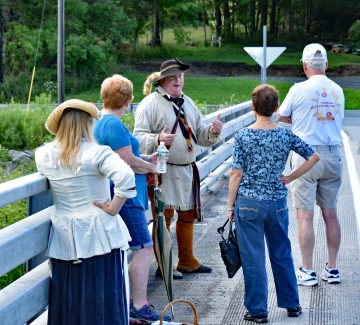
We stop on a bridge over the Cobleskill Creek to discuss the lay of the land and events leading up to the battle.
Incorporating part of the Cobleskill Creek Trail and adjacent roadways, the battlefield encompasses a quiet, beautiful farming landscape ideally suited for contemplating the din of war. The tour visits a number of key geographical and historical elements that played pivotal roles in the battle. The strengths and weaknesses of both sides are explored, as well as the terrain it was fought upon. It also provides an opportunity to get an in-depth appreciation of 18th century military tactics and weapons.
The tour is approx. 1.5 miles and 2 hrs long. There are some grassy surfaces, but most walking is done on road surfaces – both paved and dirt. It begins at the Cobleskill Creek Trail parking lot off the Warnerville Cut-off that links Rtes 7 & 10 in Warnerville.
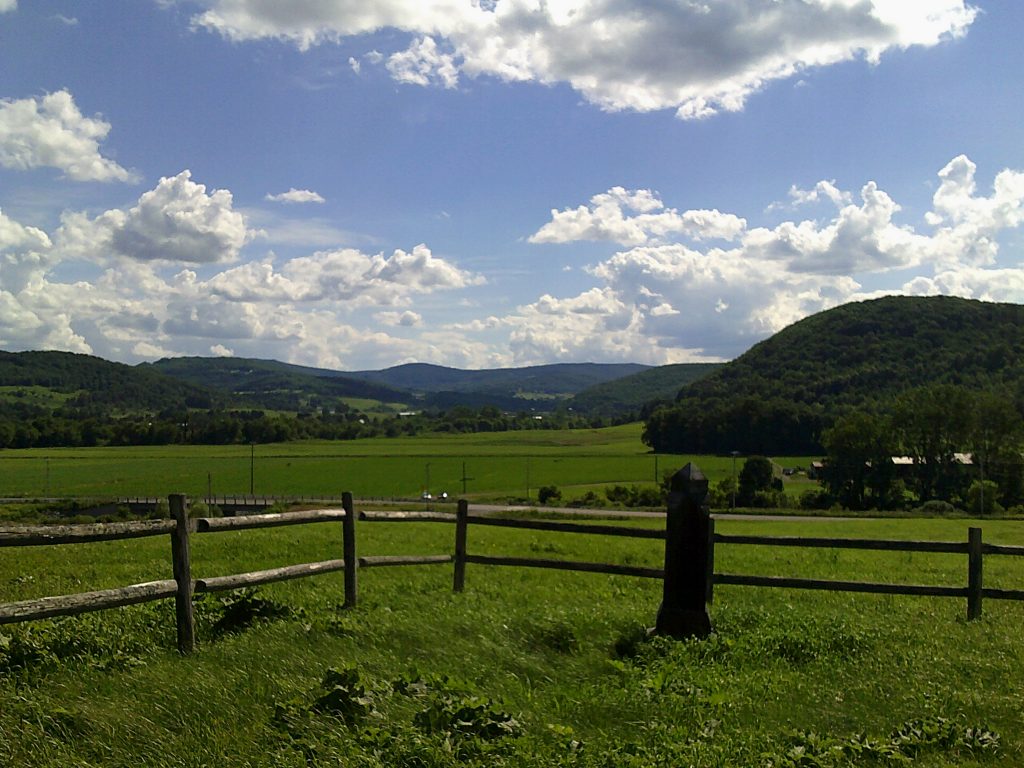
A view of part of the battlefield, now in Warnerville, looking west from the George Warner family cemetery
Highlights include the Cobus Kill settlement, the old George Warner, Sr. House, the defense of the “new” George Warner, Sr. House, the battle, the retreat, participants, and the Warner family cemetery. Also on the tour is the Haviland prehistoric occupation site that dates back over 8,000 years. A Short drive at the end brings us to the likely ambush site.
Village Of Cobleskill
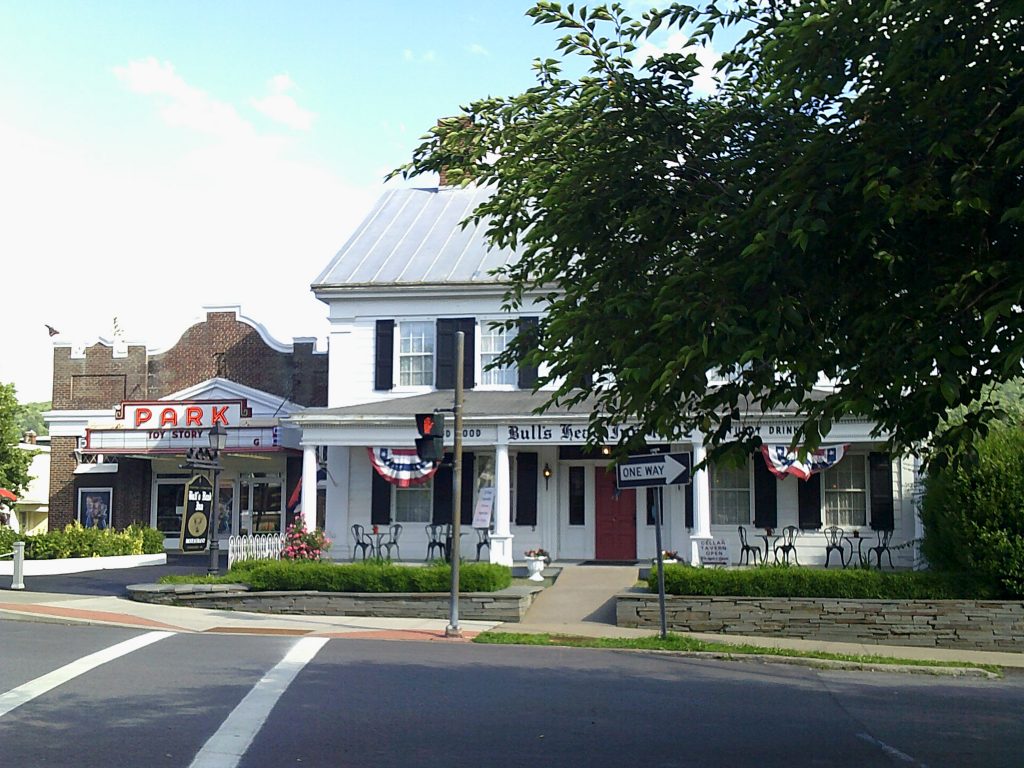
The Bulls Head Inn, on the right, is the oldest building in the Village of Cobleskill. On the left is the iconic Park Theater, which has shown movies since the Roaring 1920s.
Settled in the mid-18th century, the Village of Cobleskill, then known as Cobus Kill, was twice attacked during the American Revolution. First on May 30, 1778 after the Battle of Cobus Kill and then on August 26, 1781. Nothing survived. Parts of the settlement were rebuilt twice. Today, the downtown area has much the same appearance as during the turn of the 20th Century Gilded Age. How it got there and the events that followed become a fascinating look at how Everytown, USA developed.
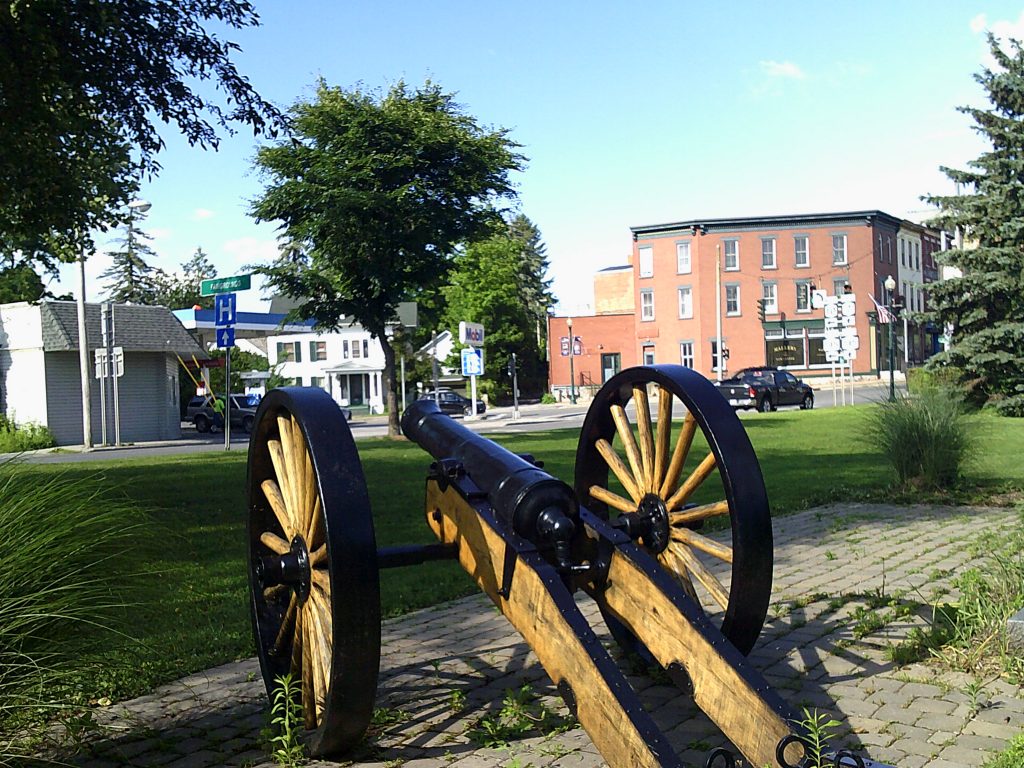
The Memorial Park site has seen many interesting changes from the colonial period to the present. Here is a cannon once thought to be from the American Revolution. Discover its real history.
Currently, this is an evening tour when there’s less traffic and a little cooler in the summer. It is timed so that the last story of the evening, Nighwatchman Matthew Wilson’s murder, is told when it is dark. A setting sun and the lights of Main Street help frame the village’s downtown area in its most attractive state. The wide variety of narratives, which also include schools, churches and ghosts, offers something for everyone. There are always growing pains in the development of any community and Cobleskill has had its share of tragedy, mayhem, and murder. There are also successes and titans of local business and industry that followed the horrors of the American Revolution.
This tour is approx. 1.5 miles and about 2 hrs long. There are grassy surfaces at the park, but otherwise walking is done on sidewalks. It begins at the village public parking lot on the corner of Main/Rte 7 and Union Streets.
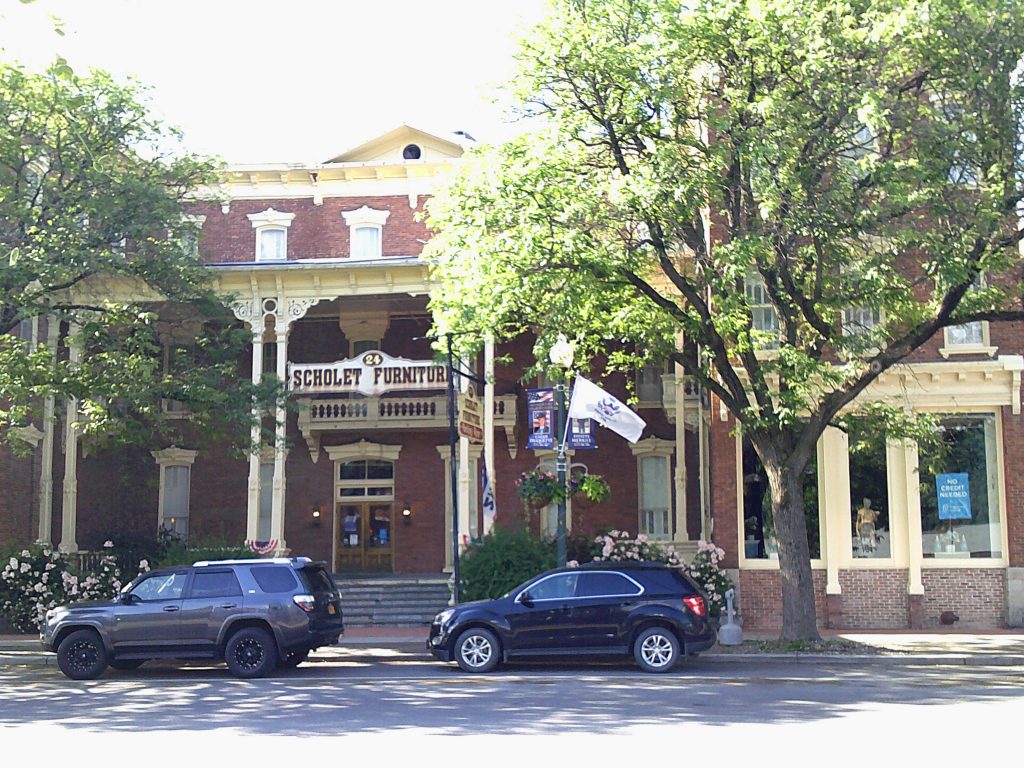
Now Scholets Furniture, The elegant Hotel Augustan attracted thousands of businessmen in its heyday. On its front steps stoodformer President Theodore Roosevelt as he delivered a speech – what was he doing there?
Highlights include the Cobus Kill settlement, its families, Fort DuBoise, Ferster property, Bull’s Head Inn, Park Theater, Murder of Nightwatchman Matthew Wilson in 1900, History of Memorial Park, The cannon, Kellog’s Artillery Company War of 1812, early churches, Railroad, Hotel Augustan, President Theodore Roosevelt’s visit and much, much more!


